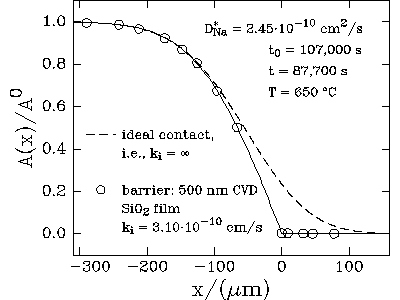Bulk Diffusion Measurements to Study the Effectiveness of Barrier Layers: II. Exchange of Sodium Between Liquid Crystal Display Glass Substrates with Different Barrier Layers
Lei Tian and Rüdiger Dieckmann
Department of Materials Science and
Engineering, Cornell University, Bard Hall, Ithaca, NY 14853-1501, U.S.A.
Abstract
Na-22 tracer diffusion experiments were performed
to study the exchange of Na ions between LCD glass substrates (Corning Code
1737) separated by different types of layers. Different types of layers were
generated (i) by RCA-cleaning, (ii) by pre-annealing in wet air, and (iii) by
low pressure CVD. A sandwich configuration was used to study the effect of such
layers between two glass substrates on the exchange of Na ions between these
substrates. The sandwiches were of the type Substrate 1 (containing Na-22
tracer) / layer / Substrate 2. Diffusion annealing of such sandwiches led to a
redistribution of the sodium tracer. This redistribution was analyzed
experimentally with regard to the sodium tracer diffusion coefficient in the
bulk and the rate of the sodium tracer transfer across the layer. It was found
that all three types of layers considered act as barrier layers, i.e., they
suppress the exchange of Na ions between glass substrates.


Experimental residual radioactivity profile for the exchange of Na-22 between two Corning Code 1737 glass samples and the surface of Sample 2 modified by a 500 nm SiO2 film generated by LPCVD. Left figure: complete profile, right figure: partial profile for x > 0 in high resolution. The solid line was obtained by data fitting and the dashed line (only visible in the left figure) corresponds to the profile to be expected in the case of an ideal contact between the two samples in the absence of the SiO2 layer.
J. Appl. Phys., 90 (8) [2001]
3810-3815